Mongolia is a huge country with a small population (and the lowest population density of any country in the world), historically wedged between two competing Communist countries. After gaining independence from China in the early twentieth century, Mongolia became a Soviet satellite state—something which has had a huge effect on the country. Russian influence is seen in everything from the second language of most older Mongolians, where older Mogolians were educated, the gauge of their railways, the architecture and design of their cities, and most palpably in the huge drop in living standards that occurred when the USSR dissolved. Even more obviously, Mongolia uses the Russian Cyrillic script, in contrast to Inner Mongolia, where the traditional Mongolian script is still in official use.
Walk around Ulaanbaatar and you can see evidence that things may have been better 30 years ago; you can also see that virtually no investment, building, or upkeep has been done in the intervening timespan; and you can't miss the signs of Mongolia's
recent, mining-driven economic growth. You'll encounter some old Soviet architecture that is quite gorgeous, a lot of very institutional Soviet-style apartment blocks in varying states of disrepair, streets that were once paved but are now almost completely dirt and gravel, ramshackle houses and ger districts that have sprouted up in the last decades, as well as shiny flashes of prosperity and Western consumerism.
 |
| A ger compound. The families living there are probably all related. Unplumbed outhouses are the norm. Ger districts are a cheap way for rural families to move to UB, and once one family member has a foothold in the city it's extremely easy for relatives to move their get to the city. When a nomadic family loses their herd in a rough winter, they move to one of these districts, and it's estimated that 700,000 of UB's residents are just these kinds of people. |
 |
| The city isn't really prepared for the sprawling development that has come with increasing urbanization. The Soviets designed the city to hold 500,000—one third of the current population. |
As a city, there's not a lot to do or see in Ulaabaatar—at least, not outside of
Naadam, the summer sporting festival that happens in Ulaanbaatar from July 11-14 (places outside of UB have their own Naadams at slightly different times). Otherwise, there are a couple of temples, a museum or two, a few other sights, but not much else. Unfortunately, UB is a place where you'll be forced to spend a fair bit of time: since UB is the only city of size, and there aren't a lot of roads, almost all travel goes through the hub of UB instead of running directly between smaller cities; and even if you are taking a private tour, you'll need to stay in UB for a while to arrange your tour unless you've spent a lot of money and booked ahead from outside Mongolia. If you're traveling independently, I suggest that you spend as little time as possible in UB when you first arrive, as you'll likely be forced to spend a few more days there later in your trip, during which time you can see what the city has to offer.
Almost all budget tours are arranged through guesthouses, which universally double as tour operators. Guesthouse tours tend to be the cheapest available, and run around $45 per day at the budget end. Most guesthouses tend to run similar itineraries, and these itineraries are pretty much exactly those listed in Lonely Planet. But the problem is that they only run when there is enough demand, so you could be waiting for a while if you want to take a specific tour. And although an all-inclusive $45 isn't terrible, on almost all tours at least a couple of those days are going to be absolutely wasted days because of the time it takes to travel to regional centers. Some tour operators will let you join a tour in the middle, for only a few days (space permitting), which can be a way to save money and limit yourself to the things you want to see (I contemplated joining a Gobi tour for a few days in Dalanzadgad, but the tour completely filled up at the last minute so they wouldn't have had space). You'll see messages in guesthouse about people looking for partners to join specific tours, and some people end up waiting for a while. Another option is to try and do things yourself: buying a motorbike and then selling it before you leave is an option, and there are lots of places near the State Department Store that sell discount outdoor gear (unlike in Nepal, it seems to be authentic gear that is a few seasons old), and lots of people buy or rent tents and sleeping bags. Given the limited bus schedules, some people try to hitchhike, but if you do this you really have to be prepared to potentially spend the night camping by the side of a road, especially if you're traveling somewhere less popular.
 |
| That van that looks like a VW bus is a virtually indestructible four-wheel drive UAZ-452 bus, first made in 1965 and still in production. Almost all guesthouse tours use them. |
Naadam
I timed my visit so that I arrived in UB on the first day of Naadam, July 11. The train arrives in the early afternoon, and by 3:30 I was at the stadium where the events, other than horse racing, occur.
Although they sell tickets to the wrestling stadium, you can get into certain sections for free. I just followed people into the entrance where there were no ticket-checkers. The stadium was fairly empty, but the area outside the stadium was much busier. There were food and drink vendors, and it was like a small-town fair.
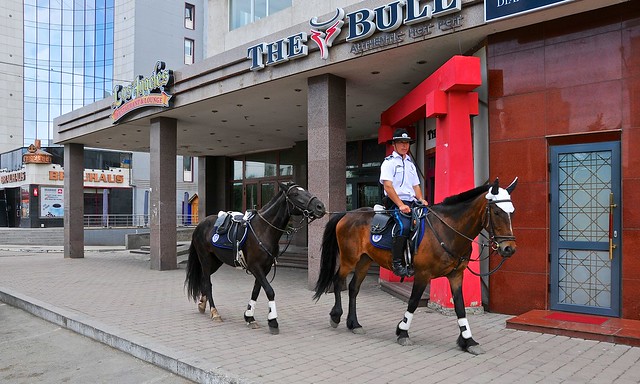 |
| I saw this in my first hour in Mongolia. It was actually pretty anomalous, even though there are horses everywhere in the countryside. |
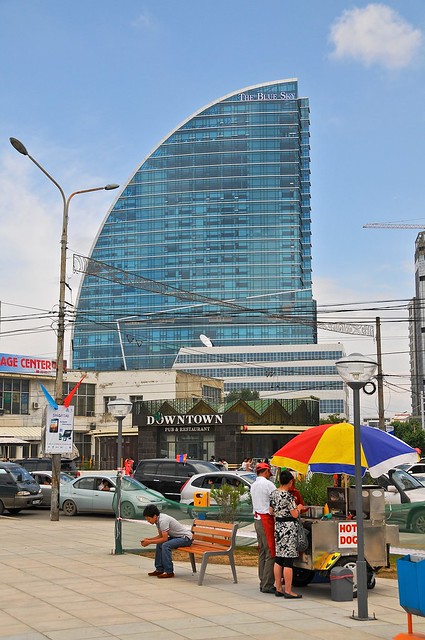 |
| The Blue Sky building behind older buildings in the downtown area, on the road south to the stadium. |
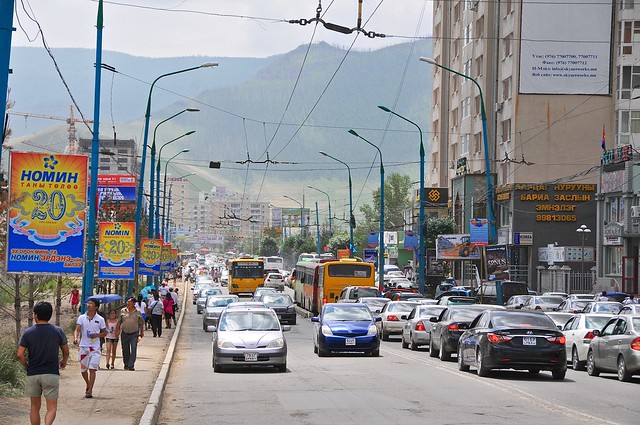 |
| Heavy traffic around the stadium. The Peace Bridge carries this street over the railway tracks and a small river, and although they were repainting some trim on the concrete railings, they were not replacing the yawning holes in the sidewalk, where square access panel for reaching the electrical cables hidden under the sidewalk were missing. Walk without paying attention—or without a flashlight at night—and you might easily end up falling down one of these holes. That's life in Mongolia. |
 |
| He's got his wrestling costume on. |
 |
| Everyone looks their best. |
Ulaanbaatar is never as interesting as it is during Naadam. The atmosphere is festive, many are in traditional dress, the streets are crowded and vibrant, and everything is very family-friendly. The actually events are something of a let down, as there's not a lot to see unless you know how to properly appreciate the events, especially since the horse racing takes place outside of town. The real attraction, however, is in watching the people, and letting the ambiance wash over you.
 |
| View from the top of the stadium. |
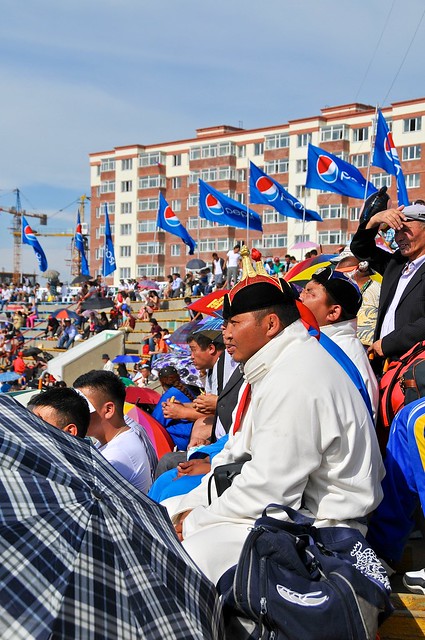 |
| Competitors sit in the stands, waiting for their time to take off their cloaks and put on their wrestling uniform. |
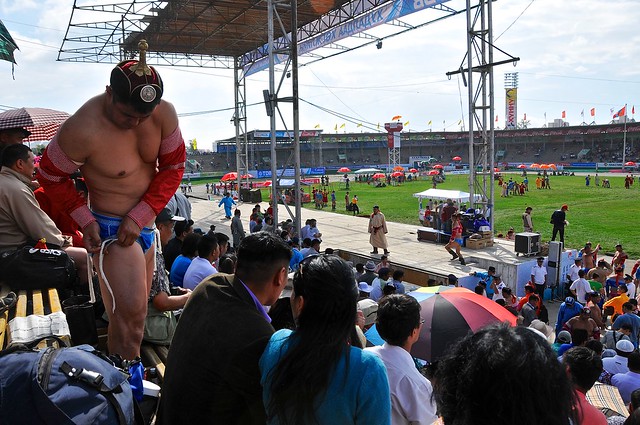 |
| Getting ready to go. |
 |
| Wrestling is a way of life in Mongolia. It's a hard-knock country, and you often see people with injuries or broken limbs. |
 |
| The wrestling happens on the grass in the middle of the stadium. Many pairs wrestle at the same time, with one judge per pair. Unlike me, the crowd knows what to look for and who to watch, so I would periodically hear roars and gasps and have no idea what the excitement was about or who they were watching. |
 |
| Taking aim. |
 |
| Preparing while the women shoot. |
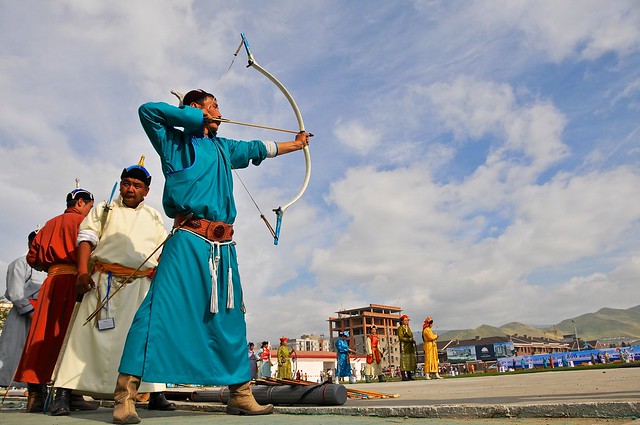
 |
|
| Entrepreneurs selling refreshments. Pouring from bottles into cups, as opposed to through a fountain system, is common in Mongolia. |
 |
| Prepared for both fire and riots. |
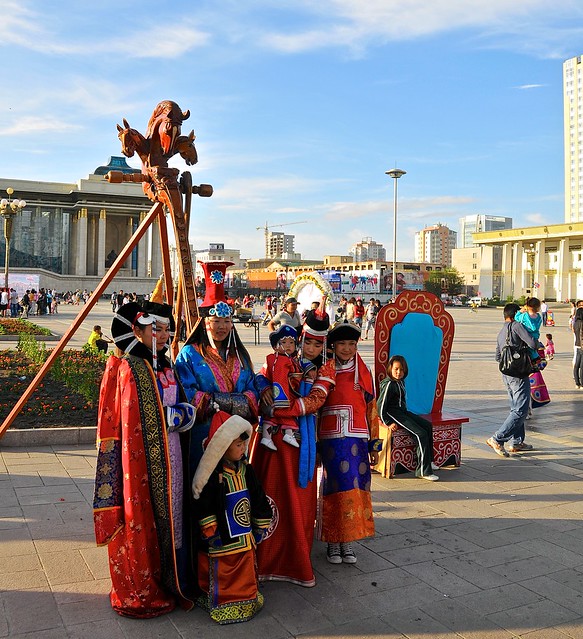 |
| A family in costume. |
 |
| Crowds gather in Sukhbaatar square for a concert. |
 |
| All dudded up in their Sunday best. |
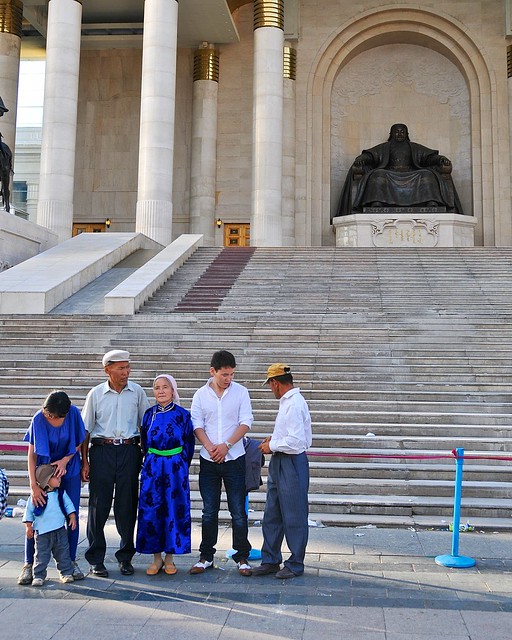 |
| Posing in front of the Chinggis Khan statue at the Parliament Building. |
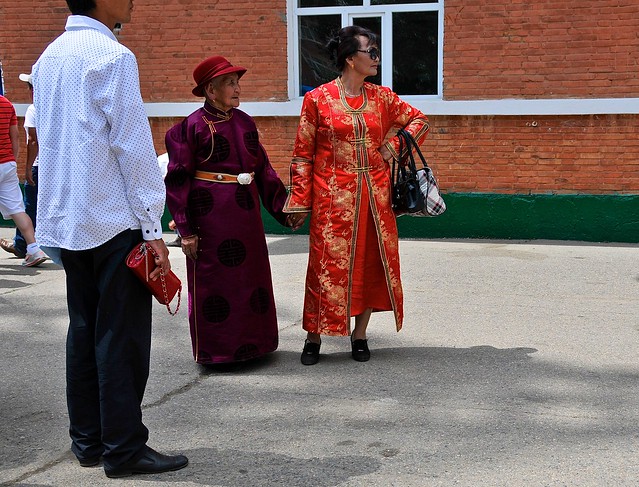 |
| Mongolians wear hats extremely well. Even the women. |
 |
| Camaraderie, not competition, seems to be the order of the day. |
 |
| Fame and glory await the successful. |
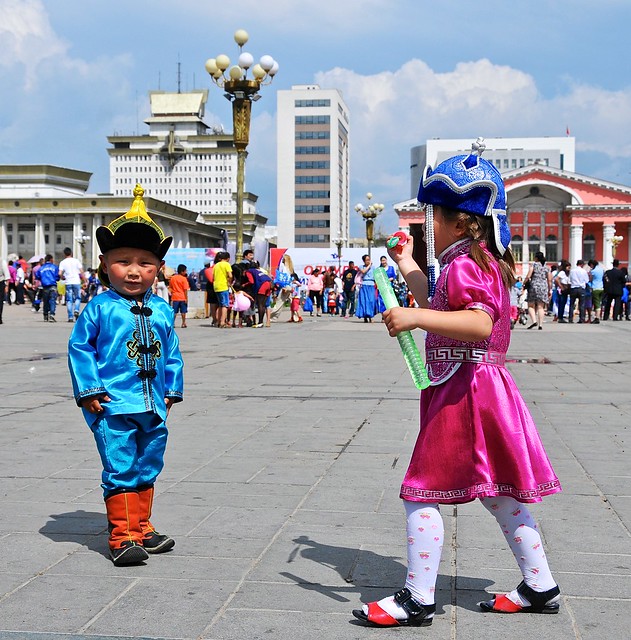 |
| Brother and sister. |
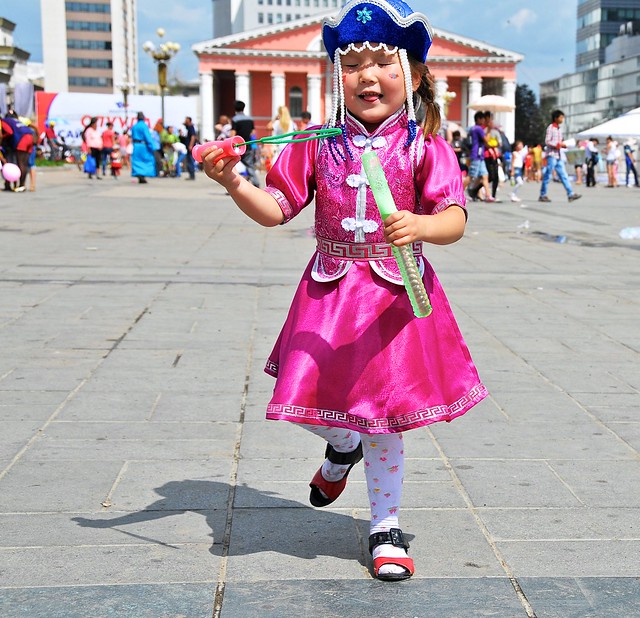 |
| Bubbles! |
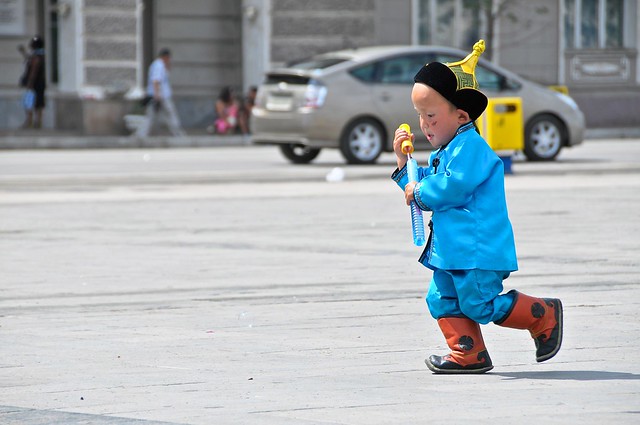 |
| People in Mongolia—which has few paved roads in the countryside, and horribly pot-holed roads in the capital—drive Priuses. I've seen them being used to drive over grasslands and through shallow rivers. What's your excuse for driving an SUV in the city, again? |
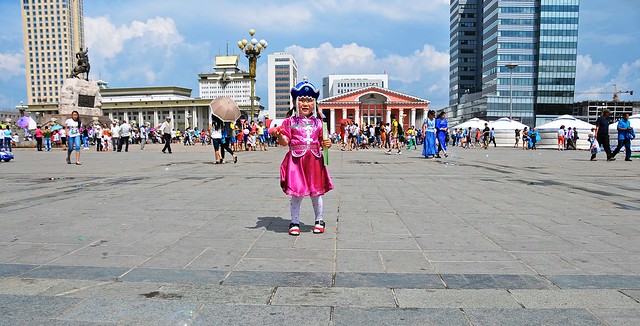 |
| Sukhbaatar square, with the pink Opera and Ballet building, and Central Tower next to it, behind the gers. Central Tower is home to luxury boutiques including Louis Vuitton. |
 |
| A slightly frightening mechanized rickshaw ride. |
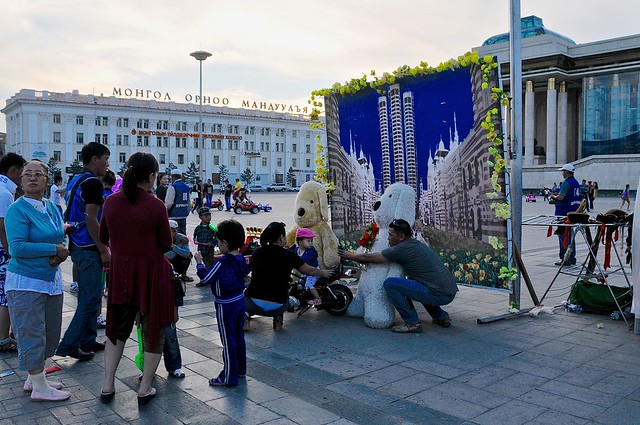 |
| Who wants a souvenir picture with UB in the background when you would have some exotic towers? |
 |
| This is Mongolia. Dirt sidewalks, horses, soviet architecture, as well as gleaming new buildings to highlight the prosperity that few can hope for. |
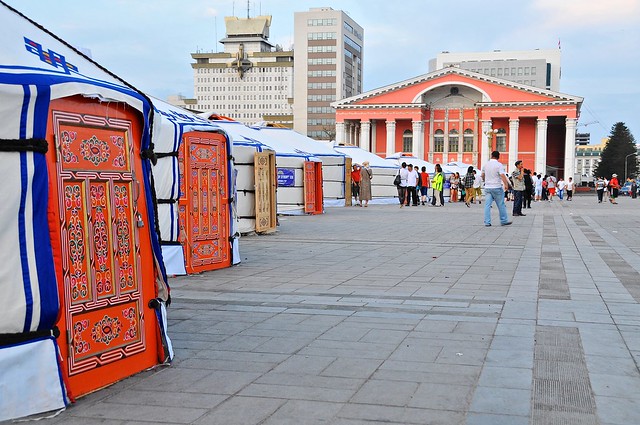 |
| Naadam is a great time to show off the latest and greatest in ger designs. |
Temples
UB's
Gandantegchinlen (or Gandan) Khiid Monastery is, along with Erdene Zuu Khiid in Kharkhorin and the remote monastery of Amarbayasgalant Khiid, on of the three most important complexes in Mongolian Buddhism (which is related to Tibetan Buddhism). Relative to the other two monasteries, however, Gandan isn't terribly exciting. Part of this is the setting—the other two are set on grassy plains—but the buildings really aren't that interesting.
What's more interesting is the Mongolian attitude towards religion. As in China and Russia, religion was banned during the communist era. In Mongolia, almost all temples were destroyed, and even in the surviving monasteries many buildings were destroyed. Some were preserved as relics to illustrate the ills of religion. Official freedom of expression only returned in 1990, but it still had much more of a base to return from than it did in China, where the Cultural Revolution was much more successful in eradicating religion than Mongolian communism was. Mongolians still seem to have a fairly cavalier approach towards Buddhism, though, and certainly don't have the reverence that you see in SE Asia. Undoubtedly part of this is compounded by the fact that Mongolian Buddhism is strongly infused with shamanistic beliefs (and indeed it really seems like Mongolian culture is primarily shamanistic, but with some Buddhist influences), as is typical with nomadic cultures that are highly dependent on the land and nature.
In terms of architecture and design,
Chojin Lama temple, located just south of Sukhbaatar square, is f greater appeal (even though it's not a functioning temple), as it feartures a number of different buildings and interiors (as well as explanations in English). The juxtaposition of the rundown temple against the modern buildings that increasingly comprise the UB skyline also adds interest.
 |
| Everyone loves pigeons. |
 |
| Like the Chinese, Mongolian kids go wherever they want. Unlike Chinese kids, trousers with split rear seams to allow easy squatting are not the norm. |
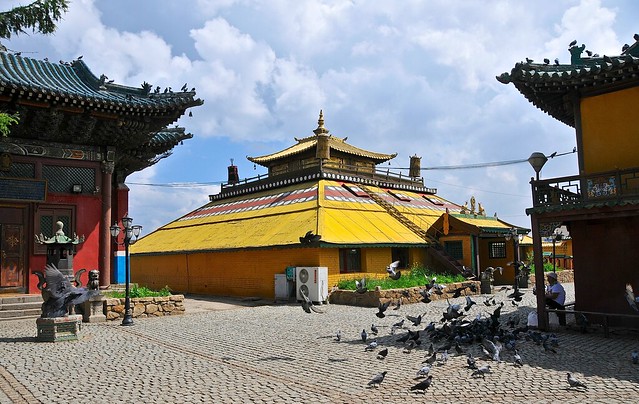 |
| The Golden Temple at the Gandan Monastery. |
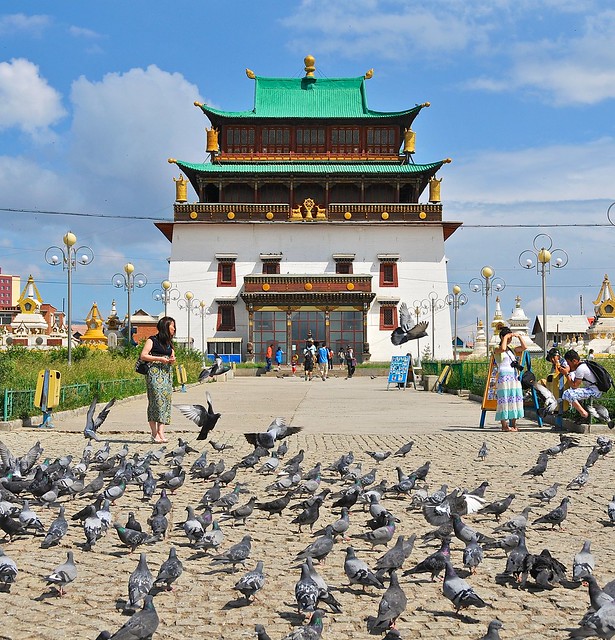 |
| Entrance to Gandan Monastery. |
 |
| Monks' quarters next to the Gandan Monastery. |
 |
| A monk making some calls. |
 |
| On the way to the monastery. |
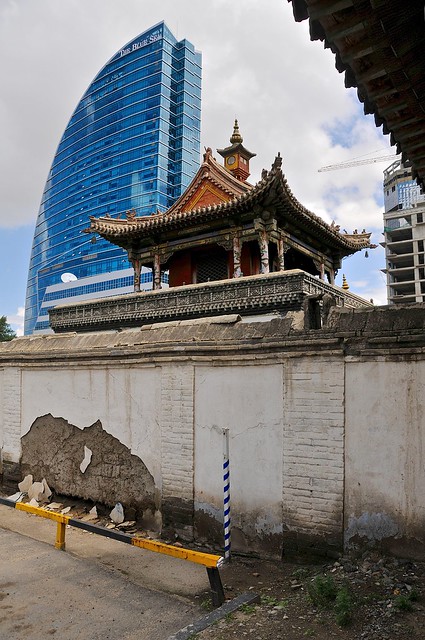 |
| Next to the Choijin Lama temple. |
 |
| A gate on the southern side of the Choijin Lama temple. |
Around UB
 |
| A monument to The Beatles, with the State Department Store in the background. |
 |
| John Lennon sings. |
The State Department Store is the largest mainstream store/mall in
UB. They sell pretty much everything, including cars. They were selling
Chevy Equinoxes for about 25% more than the price in the U.S.; while
American prices are often the lowest in the world, it is still
surprising to think that there is enough demand in Mongolia for vehicles
priced at that level, as opposed to used cars imported from neighboring
countries like Japan.
One thing you notice, at even
the best supermarkets, is the poor quality of produce available. Even
the most basic and widely used vegetables—carrots and potatoes—are often
black or rotting, and fruit is both extremely expensive and usually quite spoiled.
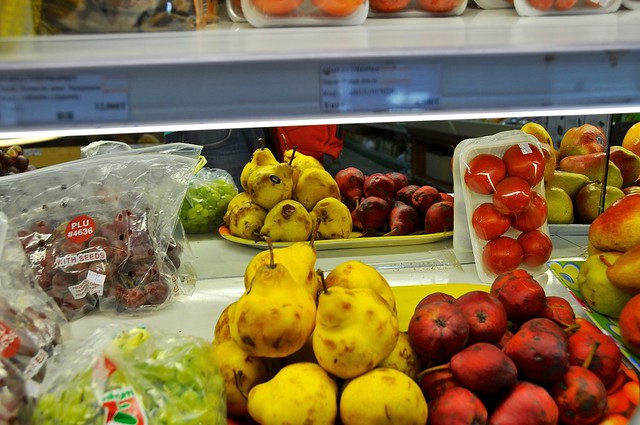 |
| Citrus fruits are your best bet if you want something without bruises, marks, or brown spots. |
 |
| Gandan Monastery. |
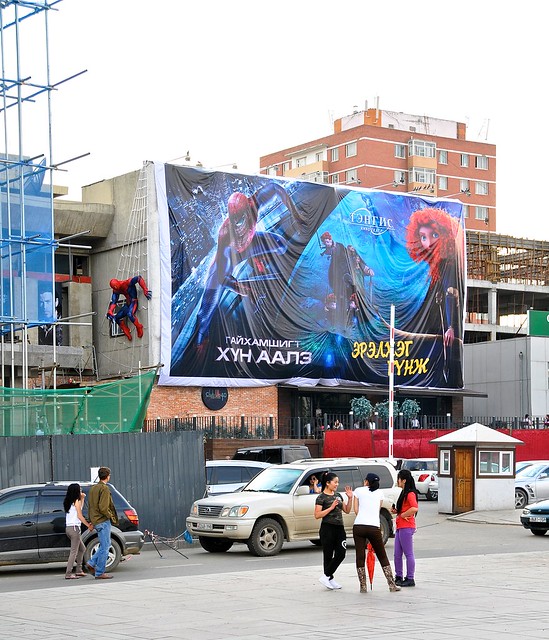 |
| The spider-man stuck to the wall is a nice touch. |
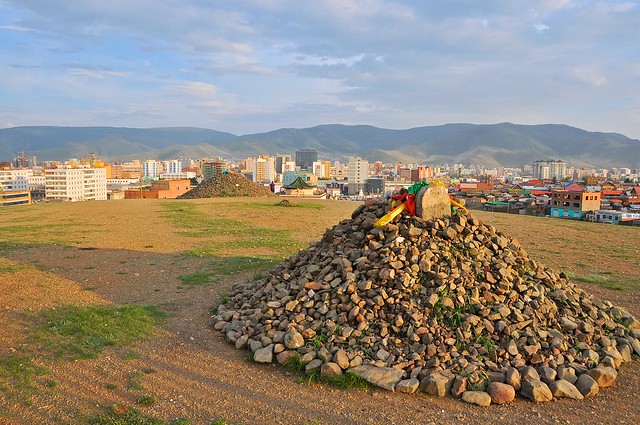 |
| Ovoo prayer mounds just east of the Gandantegchinlen Monastery. |
 |
| Windows on the Vista Office! |
 |
| The Zaisan Memorial to Russian soldiers who died in WWII is located south of the Tuul river. |
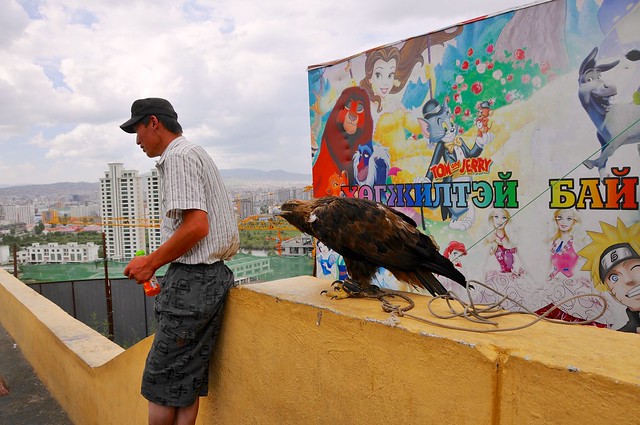 |
| Have your picture taken with a Golden Eagle—used by ethnic Kazakhs for eagle hunting in Mongolia's far west—in front of a gorgeous cartoon backdrop. |
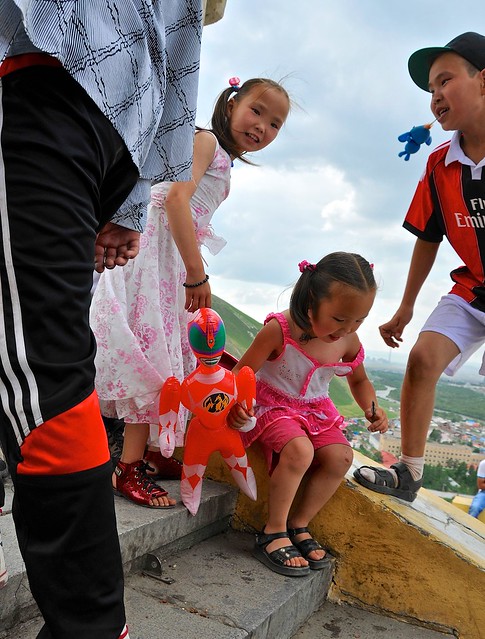 |
| Kids on their way down from Zaisan. |
 |
| Posing for pictures. |
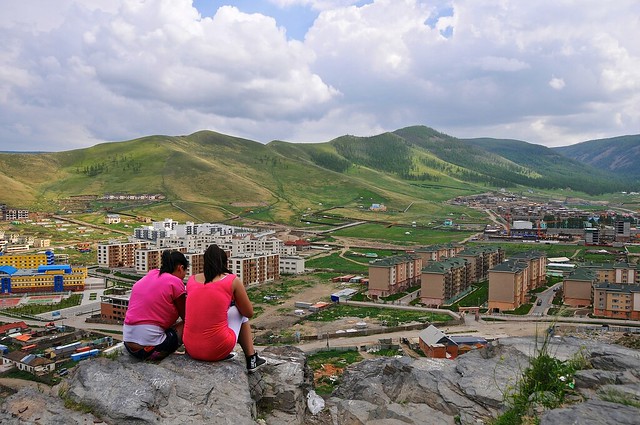 |
| Looking north towards Bogd Khan mountain and national park. |
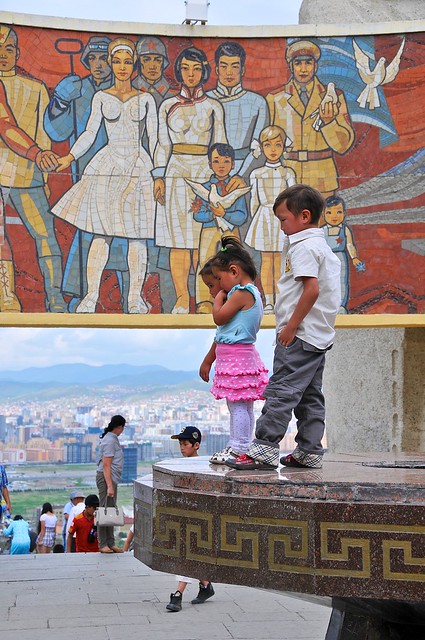 |
| Posing on the central pedestal. |
 |
| Zaisan affords panoramic views of the city. |
























































No comments:
Post a Comment